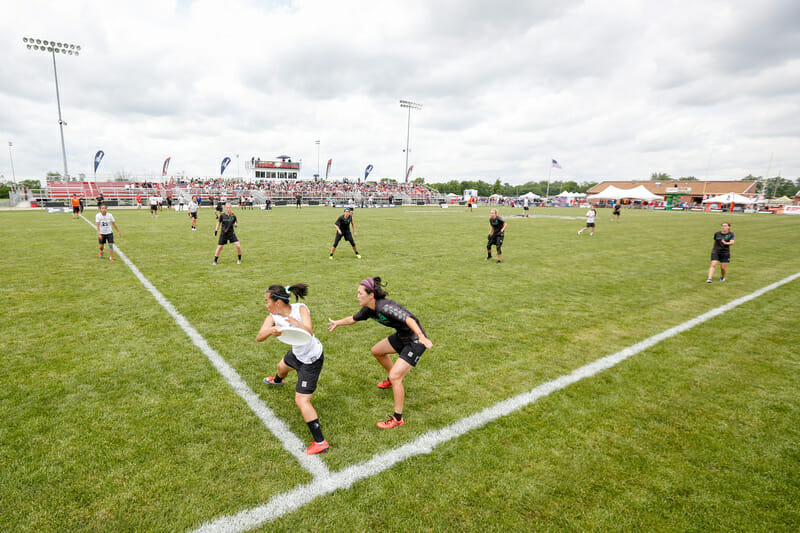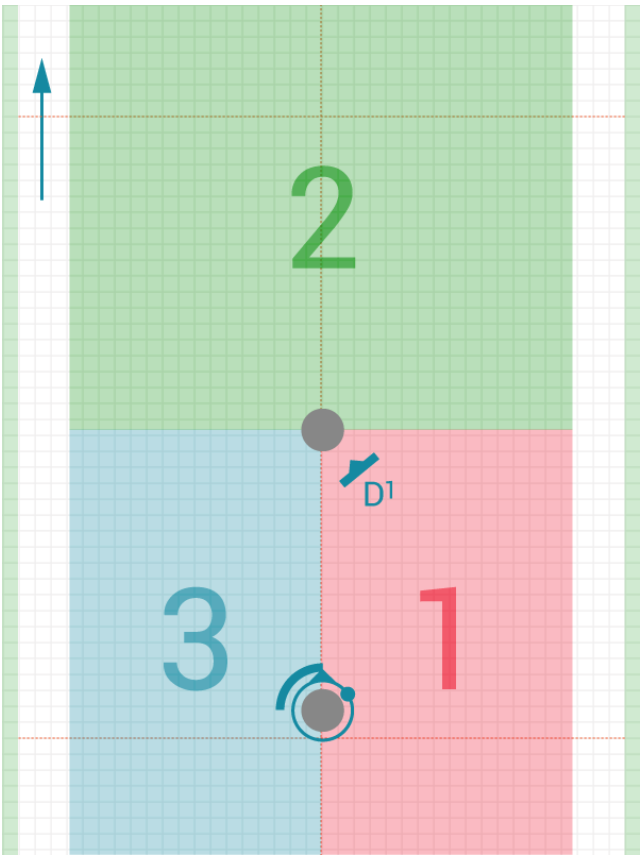A new series on ways to approach playing defense.
February 19, 2020 by Sion "Brummie" Scone in Analysis with 0 comments

This is the first post in a subscriber series on defensive strategy, tactics, and countertactics, presented by Flik.
In ultimate, almost by definition, tactics are decided before the point begins, using either an on-the-fly adjustment spoken about between points or the use of a pre-drilled tactic from practice. Only the most exceptional of teams can adjust while a point is under play, and most of the time teams will revert to their regular habits in response to different offensive or defensive looks. An offense might therefore call a particular structure or play, and a defensive unit might decide their defensive priorities, all before the point begins.
Therefore, adaptability in ultimate is a huge factor in any team’s success. One way of teaching your team to be adaptable is to give them different offensive and defensive tactics on a regular basis.
A defensive tactic is chosen specifically to prevent an offense from scoring in a certain way, yet the defense has no idea what the offense is trying to do before the pull goes up. An offensive tactic is selected with no idea what they are about to face. This creates a “cat-and-mouse” thinking game as both try to out-think as well as out-play each other.
Let’s start by assuming that offense wants to play a particular style, and it is the defense that is adapting in reaction to being easily scored upon. Offense wants to score via Plan A. Defense wants to deny Plan A and force Plan B. If the offense resorts to Plan B, this should be considered a win for the defense.
In this subscriber series, we will approach from a strategic and tactical perspective how defenses can learn to better counter an opposing offense, including suggested adjustments to make once the offense counters the initial defensive look. While this will not be entirely comprehensive, this is designed to be a broad and deep overview of defensive game plans that have been developed over the last 30 years.
Like most of my writing here in Ultiworld or over on Flik, very little of what you’re about to read was created by me. I’m merely a student of the game. So, if you’re reading something here that looks like it’s been borrowed from someone else, good. That means I’ve been paying attention. I’m sure many of those authors would say something similar about themselves. Watching great teams play is the best way of seeing how tactics evolve — unless of course you can go and talk to them and get insights that way. The more you think about the game, the more you’ll start to spot what’s happening on the field. This series is designed to help you do that.
Nomenclature
Strategy: what are we trying to achieve; e.g. “let’s pin them to the downwind side”
Tactics: how are we trying to achieve it; e.g. “let’s run a zone to push them to the sideline, transition when they are trapped”
Sadly, ultimate does not use standard words worldwide, so you might find that some descriptions are lacking terminology that you are familiar with. I’ve tried to use non-confusing, descriptive terms rather than proper nouns where possible, although clearly naming defenses is just as useful as naming offenses.
Caveats
There are no such thing as “perfect” tactics, offensively or defensively. Just opportunities to swing the odds in your favor. Good opponents will react to your counters by doing something that forces you to change again. If they don’t, or can’t, that’s when you’re more likely to have success.
Be wary of false positives. If their offense doesn’t normally turf open side passes, don’t take this a proof that your tactics are working. Likewise, false negatives need to be identified. If your tactics force some highly contested throws that are nevertheless caught for goals, this can be seen as a sign of success if you feel that your opponent is unlikely to repeat these options with a high percentage.
All defensive strategies, by their very nature, are “counter” to something. We will go over some basics to get started before looking at specifics. However, defenses need to adjust, often as soon as the pull is fielded. Get used to switching things mid-point if what you called on the line is not appropriate for the offense that you see (e.g. if you called a defense as a counter to horizontal stack, you might want to change if when your opponent comes out in a side stack).
In a similar vein, there are many different ways to play a vertical / horizontal / side stack, and therefore individual defensive schemes might need to micro-adjust further to more precisely fit the offense they are trying to stop. If you know a particularly effective defense against a particular playing style that differs heavily from what I’ve put, then it is possible that you’re used to seeing a different style of offense, or you simply have evolved your defense further than mine.
Team Defensive Schemes
The number one priority when playing defense is being organized. Everyone on the team must know exactly what you’re trying to do and how you’re seeking to generate turnovers. While this level of understanding is typical when teams play a zone defense, I’m continually surprised at how often teams playing matchup defense don’t all play the same scheme. This can lead to gaps in defensive coverage which offenses can exploit.
Probably the most effective and common defense is to prioritize protecting the open under space first, then contesting the away space. Preventing the open side under throw is vital, otherwise your opponent will just take easy throws all the way down the field.
The below diagram gives an overview of the key areas on the field. The grey dots represent offensive players; the blue lines represent defenders. The disc (the blue dot) is in the hands of the lower grey dot.

What is your goal as a defense? Are you trying to stop open side unders while limiting the danger of deep throws? Or is it windy, making deep throws more difficult, causing you to prioritize stopping throws to zones 1 and 3 and daring the offense to throw it long? There should be a coherent plan in place, even if it changes from point to point.
In the next installment, we will discuss matchup defensive approaches, beginning with an analysis of marking strategies against common offensive structures. What you do on the mark — forcing a side, forcing straight up, forcing middle — defines what the rest of the defense will do downfield.
Join us shortly for part two!